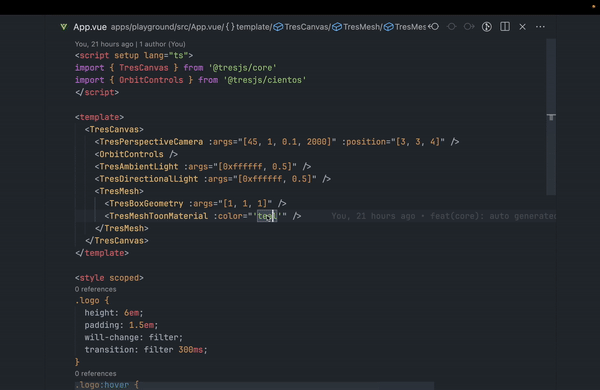Migration Guide
This guide is intended to help you migrate from v1 to the newest versions of TresJS 🤩✨.
pnpm update @tresjs/corenpm update @tresjs/coreyarn upgrade @tresjs/coreWhat's new?
Vue Custom Renderer
TresJS is now a Vue Custom Renderer 🎉 that lives inside of a wrapper component called TresCanvas that is responsible for creating the WebGLRenderer and the Scene for you and creating a new Vue App instance to render the scene.
Typescript support and Intellisense 🦾

This was probably the most requested feature for TresJS. Now Tres components work with Volar and provide type intellisense.
TresJS now generates type declaration on build time for all the components based of the catalog from ThreeJS. This means that you can use all the components from ThreeJS and get type intellisense for them.
Tres Plugin is optional 👍
The TresPlugin is now optional. You can use TresJS without it by importing the components directly from tresjs/core:
<script setup lang="ts">
import { TresCanvas } from '@tresjs/core'
</script>
<template>
<TresCanvas>
<TresPerspectiveCamera
:position="cameraPosition"
:fov="cameraFov"
:aspect="cameraAspect"
:near="cameraNear"
:far="cameraFar"
/>
<TresMesh :geometry="geometry" :material="material" />
</TresCanvas>
</template>INFO
This is recommended for performance and bundle size reasons, tree-shaking will work better and you will only import the components that you use.
TresScene no longer needed
The <TresScene /> component is now deprecated since the scene is now created by the <TresCanvas />.
In the beginning, I thought that it would be a good idea to have a separate component for the scene in terms of verbosity and keep it as similar to plain ThreeJS, but it turned out that it was not really useful.
You can now create a scene like this:
<template>
<TresCanvas>
<TresPerspectiveCamera
:position="cameraPosition"
:fov="cameraFov"
:aspect="cameraAspect"
:near="cameraNear"
:far="cameraFar"
/>
<TresMesh :geometry="geometry" :material="material" />
</TresCanvas>
</template>To migrate your code, you can just remove the <TresScene /> component and move the children to the <TresCanvas /> component.
useCatalog is now deprecated
The useCatalog function is now deprecated. You can now import the catalog directly from @tresjs/core
You can read more about it here: Extending
Change this:
// Wrong ❌
import { useCatalog } from '@tresjs/core'
import { TextGeometry } from 'three/addons/geometries/TextGeometry'
const { extend } = useCatalog()
extend({ TextGeometry })To this:
// Correct ✅
import { extend } from '@tresjs/core'
import { TextGeometry } from 'three/addons/geometries/TextGeometry'
// Add the element to the catalogue
extend({ TextGeometry })Model's ref value getModel is now deprecated
The getModel function is now deprecated. You can now use the model property directly.
Change this:
// Wrong ❌
<script setup lang="ts">
import { useGLTF } from '@tresjs/cientos'
const { scene, nodes, animations, materials } = await useGLTF('/models/AkuAku.gltf', { draco: true })
const modelRef = ref()
watch(modelRef, ({ getModel }) => {
const model = getModel()
model.position.set(0, 0, 0)
})
</script>
<template>
<primitive :object="nodes.MyModel" />
</template>To this:
// Correct ✅
<script setup lang="ts">
import { useGLTF } from '@tresjs/cientos'
const { scene, nodes, animations, materials } = await useGLTF('/models/AkuAku.gltf', { draco: true })
const modelRef = ref()
watch(modelRef, (model) => {
// Do something with the model
model.position.set(0, 0, 0)
})
</script>
<template>
<primitive :object="nodes.MyModel" />
</template>Cameras need to be before any control 🎥
The TresOrbitControls component needs to be after the camera in the tree. This is because the controls need to know the camera to work.
Change this:
// Wrong ❌
<template>
<TresCanvas>
<TresOrbitControls />
<TresPerspectiveCamera />
</TresCanvas>
</template>To this:
// Correct ✅
<template>
<TresCanvas>
<TresPerspectiveCamera />
<TresOrbitControls />
</TresCanvas>
</template>UseTres is now useTresContext ^3.0.0
For v3 we reworked the whole state logic to make it more flexible and easier to use for plugin authors and ecosystem packages. Instead of using a store like in v2, we now use a context provider based on provide/inject.
The useTres function is now an alias of the useTresContext function to avoid breaking demos and experiments out there, but consider using useTresContext from now on.
Instead of a big reactive object, you will now get the scene and renderer refs, between other properties, directly.
Change this:
// Wrong ❌
import { useTres } from '@tresjs/core'
const { state, setState } = useTres()
console.log(state.scene)To this:
// Correct ✅
import { useTresContext } from '@tresjs/core'
const { scene, renderer } = useTresContext()
console.log(scene.value)For more detailed information about the new context provider system, you can read the API DOCS section.